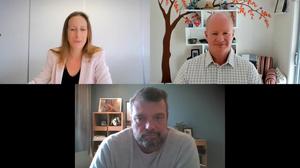Dr Karen Morley is a distinguished executive coach, an authority on leadership coaching and a thought leader on inclusive leadership. She is the author of FlexAbility: How high achievers beat burnout and find freedom in an overworked world, Beat Gender Bias, Lead Like a Coach, and Gender-Balanced Leadership.
Trust takes effort, and it requires evidence that can be difficult to provide when you are working remotely. When personal interactions reduce, become less personal or don’t give the same amount of information, trust is at risk. One of the catchcries of the increase in remote work is the lack of personal connection, which has increased the fragility of trust.
We are used to developing trust through repeated interactions with people. Over time, trust develops to the extent we are confident that people are:
- credible – they have the skills to do what they say they can
- reliable – they do what they say they will do, and
- caring – they support you.
The first two of these, credibility and reliability, rely on knowing whether people have the skills and qualities they need to do the task and comprise Cognitive trust. Emotional trust is shown through care and concern for each other, and it creates a positive climate for working together.
Three weeks into her new role, a CMO found herself left out of casual conversations with her new colleagues. The development of trust is vital at this early stage in a role. In the office it would have been easy to drop by to share small snippets of news or suggest a coffee break. It would have been easier for her to take some control of her onboarding. She hadn’t even met her colleagues, and the lack of interaction led to a great deal of doubt and extra work on her part to identify ways to increase connection with them.
Building trust when you are working remotely requires a few different techniques than when you are working face-to-face. Rather than asking, ‘Do I trust my colleagues?’ Professor Tsedal Neeley, author of The Remote Work Revolution, suggests it’s more useful to ask, ‘How much do I need to trust them?’
When there’s a brief task to complete, or you’re in crisis mode, or there’s a time-limited project to complete, focus on trusting others until there’s a reason not to. Make sure everyone has information about people’s competence to do the work, assume the best and complete the task. Avoid overinvesting in building trust that’s not needed for time-limited projects such as these.
Over time, or if you regularly work with colleagues, you get to see what they do and hear what they say. Through repeated interactions, you discover people are credible and reliable.
Having your own ‘early warning system’ that identifies potential risks, such as a lack of skills or missed minor milestones, is pretty important too. Being able to identify and raise these concerns early helps to shore up your trust in others, and theirs in you.
While cognitive trust is useful for communicating and working across teams and with other organisations, it’s not sufficient for remote teams. Remote teamwork needs both cognitive and emotional trust. Emotional trust is where additional investment is almost always needed.
Emotional trust means we need to get personal. Do that by:
- learning about people’s lives and how they work
- sharing personal information about your own life and
- seeking to understand how others see you.
The more context you have about people and how they work, the easier it is to care about them. Understanding how they see you is just as important: If you don’t think they care about you, trust will wither. Paying attention to how team members work helps to develop shared patterns and norms.
Make yourself known
One of the best ways to share such information is to begin – and sometimes to end – meetings with casual conversations, such as what you will be working on next, if you need any help on a project, or whether the new system working out for you.
Leaders set the standard by guiding conversations so they are not always simply about work. Virtual tea and coffee chats, birthday celebrations and walk-and-talks are all good ways to do this. They should be focused on sharing information about outside work interests, daily routines, preferences, workspaces and the mix and interplay of daily life. Let people know what you like, prefer and believe, such as food preferences, and get to know theirs.
For leaders, one of the most powerful ways you can accelerate emotional trust is to make yourself known to others. You lead the way: If you don’t share and show you care about others and their lives, emotional trust will be stifled.
Self-disclosure means being open to sharing information about yourself. That doesn’t mean over-disclosing – getting too personal will have the opposite effect. Decide what level of intimacy is appropriate. Aim for the Goldilocks method: Not too much, not too little – just right.
For example, instead of saying you’re not available for a meeting, say instead ‘I can’t meet at that time because I have to take my car for servicing. I know that puts a bit of a squeeze on your timeline. What else can we do?’
Consider how much time to devote to the personal and develop a regular rhythm for it.
While you’re leading the way, make sure you don’t do all the talking. Make sure sharing is not one-sided but roughly equal around the team.
Also, make sure it’s truthful. Recognise that different people have different preferences for disclosing, so don’t force it, make it competitive or push people to say more than they are comfortable to.
Personal disclosure increases closeness and likeability. The more you learn about someone, the easier it is to like them and to feel close to them, and the easier it is to show care and give support. That builds emotional trust, despite remote work conditions.
Tags: remote working, leadership, CMO role, marketing leadership








